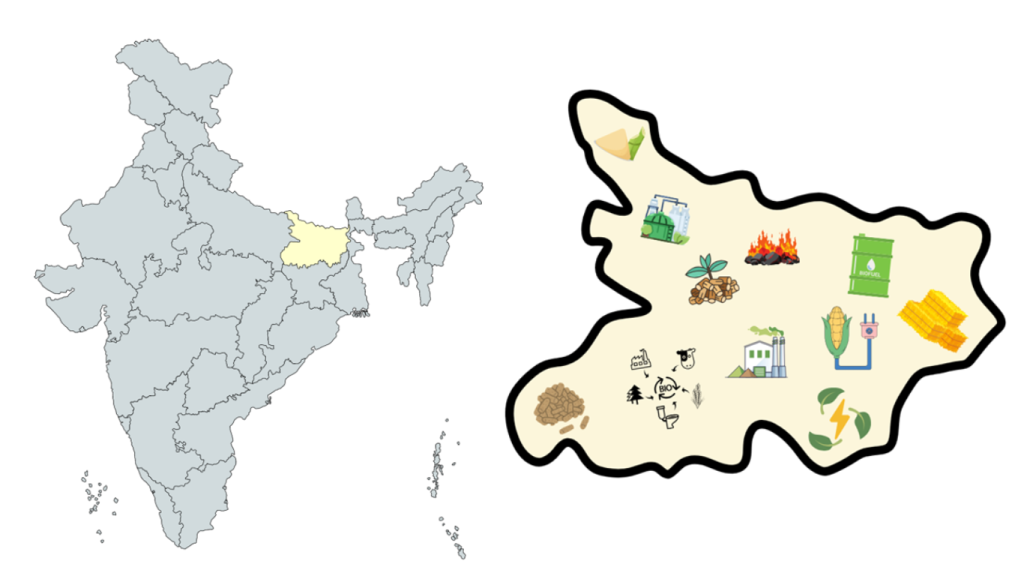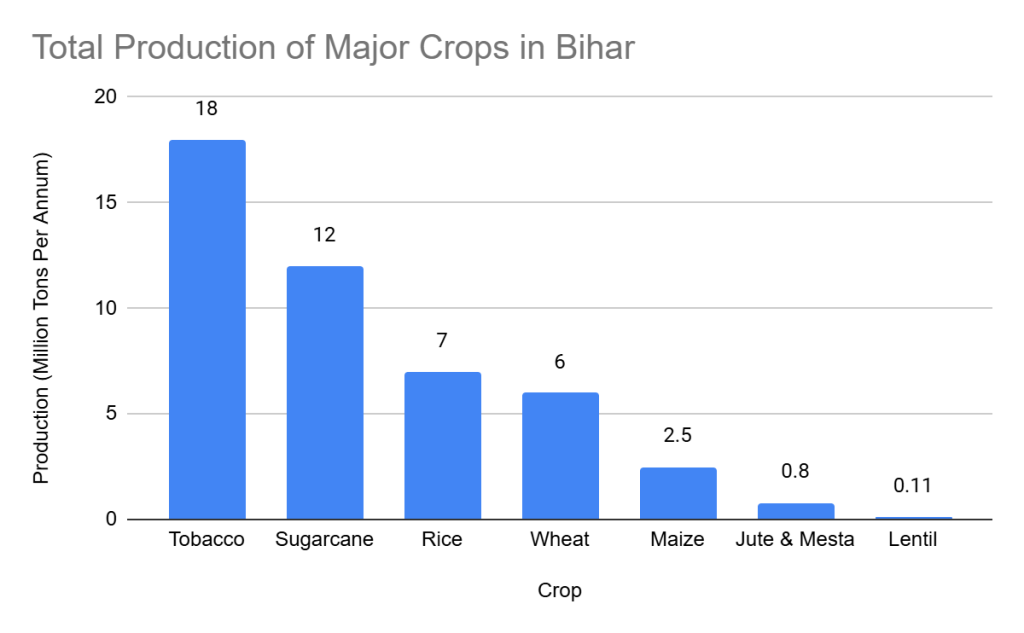
Key Questions Answered in this Section
- What are the major crops contributing to biomass feedstock production in Bihar?
- Which regions in Bihar are known for cultivation of prominent crops?
- Which types of biomass residues are generated in Bihar?
- What are the biomass clusters in Bihar?
- How is the biomass supply chain in Bihar?
- How much sugarcane trash and bagasse is generated in Bihar?
- How much rice straw is generated in Bihar?
- How much rice husk is generated in Bihar?
- How much wheat straw is generated in Bihar?
- How much maize cob and husk is generated in Bihar?
Bihar comprises a mix of urban and rural regions, with the top urban areas being Patna, Gaya, Bhagalpur, Muzaffarpur, Purnia, Darbhanga, Bihar Sharif, Arrah, Begusarai, and Katihar. Understanding the biomass supply chain in Bihar is crucial for optimizing the utilization of agri residues and enhancing the state’s bioenergy potential
Major Crops Grown
| Crop | Production (Million Tons Per Annum) |
| Tobacco | 18 |
| Sugarcane | 12 |
| Rice | 7 |
| Wheat | 6 |
| Maize | 2.5 |
| Jute & Mesta | 0.8 |
| Lentil | 0.11 |

The cultivation of these crops results in substantial biomass feedstock, contributing significantly to Bihar’s bioeconomy.
Residue Generation
| Crop | Residue Parts | Production (Million Tons) |
| Sugarcane | Trash, bagasse | 4.3 |
| Rice | Straw, husk | 11.75 |
| Wheat | Straw | 1.9 |
| Maize | Cob, Husk | 0.75 |

Efficient management of these crop residues is essential for developing a sustainable biomass supply chain in Bihar.
Significant Regions of Availability
- Sugarcane: Muzaffarpur, Samastipur, West Champaran, East Champaran, Sitamarhi
- Rice: Rohtas, Aurangabad, East Champaran, West Champaran, Madhubani
- Wheat: Rohtas, Bhojpur, Buxar, Aurangabad, Patna
- Maize: Purnia, Katihar, Kishanganj, Araria, Khagaria
Identifying these biomass clusters enables targeted strategies for biomass feedstock collection and utilization.
Prominent Crops in Different Regions of Bihar
Each region’s unique crop profile contributes to the diversity of agricultural residues, impacting the overall biomass availability in Bihar.
| Region | Prominent Crops |
| Muzaffarpur | Sugarcane |
| Samastipur | Sugarcane |
| West Champaran | Sugarcane, Rice |
| East Champaran | Sugarcane, Rice |
| Sitamarhi | Sugarcane |
| Rohtas | Rice, Wheat |
| Aurangabad | Rice, Wheat |
| Madhubani | Rice |
| Bhojpur | Wheat |
| Buxar | Wheat |
| Patna | Wheat |
| Purnia | Maize |
| Katihar | Maize |
| Kishanganj | Maize |
| Araria | Maize |
| Khagaria | Maize |
Utilization of Crop Residues at the Farmer’s Level in Bihar
- Essential Usage for Livestock and Fertilizer
- Residues from crops like Maize, Masoor, Moong, Potato, Rice, and Wheat are extensively used for cattle feeding.
- Residues of Masoor, Moong, and Potato are utilized for preparing compost fertilizers.
- Specific Usage in Rice Processing
Rice straw and husk are commonly used for parboiling rice. - Fuel Usage for Domestic Needs
Stalks of Rapeseed & Mustard, Pigeon Pea, Mesta, and Sunflower are used as domestic fuel. - Field Preparation through Residue Burning
Stubbles of Rice and Rapeseed & Mustard are often burned openly to prepare fields for the next crop cycle. - Commercial Applications
Farmers earn additional income by selling crop residues to briquetting or biomass plants, creating an economic market for agricultural waste.

